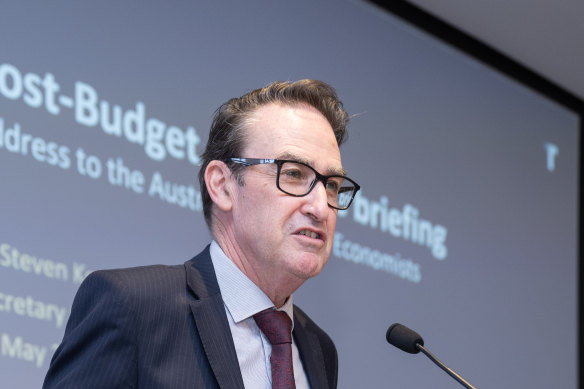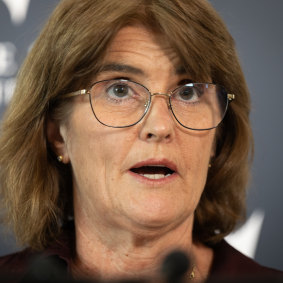Opinion
What’s happening in the economy is that no one’s sure what’s happening
Ross Gittins
Economics EditorTreasury secretary Dr Steven Kennedy let something slip when he addressed a meeting of business economists last week. He said it was too early to say if the economy was back in a more normal period, “perhaps because no one is quite sure what normal is any more”.
This was especially because “unusual economic outcomes are persisting,” he added.

Treasury secretary Steven Kennedy last week said no one is quite sure what “normal” is for the economy.Credit: AFR
Actually, anyone in his audience could have said the same thing – but they didn’t, perhaps because they lacked the authority of the “secretary to the Treasury”.
No, standard practice among business economists and others in the money market is to make all predictions with an air of great certainty. Forgive my cynicism, but this may be because their certain opinion changes so often.
Often, it changes because something unexpected has happened in the US economy. Many people working in our money market save themselves research and thinking time by assuming our economy is just a delayed echo of whatever’s happening in America.
If Wall Street has decided that America’s return to a low rate of inflation has been delayed by prices becoming “sticky”, rest assured it won’t be long before our prices are judged to have become sticky as well.
But predicting the next move in either economy has become harder than we’re used to. Kennedy noted in his speech that, in recent years, the global economy, including us, had been buffeted by shared shocks, such as a global pandemic, disruptions to the supply of various goods, and war.
One factor I’d add to that list is the increasing incidence of prices being disrupted by the effects of climate change, particularly extreme weather events, but also our belated realisation that building so many houses on the flood plain of rivers wasn’t such a smart idea.
All these many “shocks” to the economy have knocked it from pillar to post, and stopped it behaving as predictably as it used to. But, as we’ll see, not all the shocks have been adverse.
Right now, the change everyone’s trying to predict is the Reserve Bank’s next move in its official interest rate, which most people hope will be downward.

RBA governor Michele Bullock says the road to an interest rate cut will be “bumpy”.Credit: Louie Douvis
Normally, that would happen just as soon as the Reserve became confident the inflation rate was on its way down into the 2 to 3 per cent target range. And normally, we could be confident the first downward move would be followed by many more.
But since, like Kennedy, the Reserve is not quite sure what normal is, and Reserve governor Michele Bullock says she expects the return to target to be “bumpy”, it may delay cutting rates until inflation is actually in the target zone.
If so, and remembering that monetary policy, that is, interest rates, affects the economy with a “long and variable lag”, the Reserve will be running the risk that it ends up hitting the economy too hard, and causing a “hard landing” aka a recession, in which the rate of unemployment jumps by a lot more than 1 percentage point.
Kennedy was at pains to point out that the rise in the official interest rate of 4.25 percentage points over 18 months is the “sharpest tightening” of the interest-rate screws since inflation targeting was introduced in the early 1990s.
He also reminded us how much help the Reserve’s had from the Albanese government’s fiscal policy, which has been “tightened at a record pace”. Measured as a proportion of gross domestic product, the budget balance has improved by about 7 percentage points since the pandemic trough. Add the states’ budgets and that becomes 7.5 percentage points.
That’s a part of the story those in the money market are inclined to underrate, if not forget entirely. Kennedy reminded them that, since 2021, our combined federal and state budget balance has improved by more than 5 percentage points of GDP. This compares with the advanced economies’ improvement of only about 1.5 percentage points.
So, has our double, fiscal as well as monetary, tightening had much effect in slowing the growth of demand for goods and services and so reducing inflationary pressure?
Well, Kennedy noted that, over the year to December, households’ consumption spending was essentially flat. And consumer spending per person actually fell by more than 2 per cent.
When you remember that consumer spending accounts for more than half total economic activity, this tells us we’ve had huge success in killing off inflationary pressure. And this week, when we see the national accounts for the March quarter, they’re likely to confirm another quarter of very weak demand.
So, everything’s going as we need it to? Well, no, not quite.
Last week we learnt that, according to the new monthly measure of consumer prices, the annual inflation rate has risen a fraction from 3.4 to 3.6 per cent over the four months to April.
“Oh no. What did I tell you? The inflation rate’s stopped falling because prices are “sticky”. It’s not working. Maybe we need to raise interest rates further. Certainly, we must keep them high for months and months yet, just to be certain sure inflation pressure’s abating.”
Well, maybe, but I doubt it. My guess is that a big reason money market-types are so twitchy about the likely success of our efforts to get inflation back under control is the lack of blood on the streets that we’re used to seeing at times like this.
Why isn’t employment falling? Why isn’t unemployment shooting up? Why are we only just now starting to see news of workers being laid off at this place and that?
It’s true. The rate of unemployment got down to 3.5 per cent and, so far, has risen only to 4.1 per cent. Where’s all the blood? Surely, it means we haven’t tightened hard enough and must keep the pain on for much longer?
But get this. What I suspect is secretly worrying the money market-types, is something Kennedy is pleased and proud about.
“One of the achievements of recent years has been sustained low rates of unemployment,” he said last week. “The unemployment rate has averaged 3.7 per cent over the past two years, compared with 5.5 per cent over the five years prior to the pandemic.”
Our employment growth has been stronger than any major advanced economy over the past two years, he said. Employment has grown, even after accounting for population growth.
And we’ve seen significant improvements for those who typically find it harder to find a job. Youth unemployment is 2.6 percentage points lower than it was immediately before the pandemic.
So, what I suspect the money market’s tough guys see as a sign that we haven’t yet experienced enough pain, the boss of Treasury sees as a respect in which all the shocks that have buffeted us in recent times have left us with an economy that now works better than it used to.
And Kennedy has a message for the Reserve Bank and all its urgers in the money market.
“It is important to lock in as many of the labour market gains as we can from recent years. This involves macroeconomic policy aiming to keep employment near its maximum sustainable level consistent with low and stable inflation,” he said.
The Business Briefing newsletter delivers major stories, exclusive coverage and expert opinion. Sign up to get it every weekday morning.